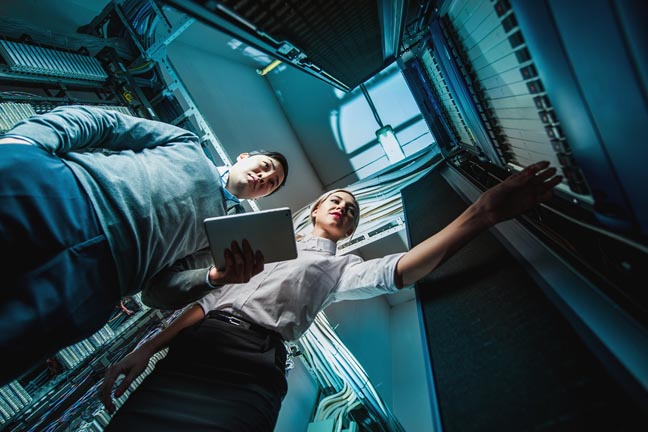The Best Use For Those Latest Manycore Chips? AI, Say Server Vendors

Analysis Anyone wondering what the target market is for manycore monster chips - like AMD's newly unveiled 5th Gen Epyc processors - won't have to wait long: server vendors reckon that more and beefier AI systems are just the ticket.
AMD has now officially unveiled its next-gen "Turin" server chips as the Epyc 9005 Series. These come in two variants: one line with between eight and 128 performance cores, and another that serves up between 96 and 192 density-optimized cores.
Some are concerned a system with that many cores represents a risk, in that if they are fully utilized, a single server will end up handling a large number of workloads that will all fail simultaneously, should anything go amiss with the system.
This hasn't deterred the big vendors, which are already riding the AI wave by selling boxes kitted out with GPUs, many of them aimed at the hyperscale companies that offer AI services or rent out virtual machines with GPU capability to end users.
Consequently, HPE and Dell have been quick to detail new hardware based on the latest Epyc chips with a definite focus on AI processing. In fact, both were on stage at the big launch event for the new silicon, gushing over their respective agreement with AMD and AI.
For HPE, this takes the form of the HPE ProLiant Compute XD685, a new model in the company's line of systems touted as optimized for AI workloads. This unit goes all-in on AMD technology, featuring not just a pair of the company's 5th Gen Epyc CPUs but also up to eight of the new AMD Instinct MI325X accelerators or the existing MI300X model, all in a 5U rack-mount chassis.
However, while this system is available to order immediately, buyers won't be able to get their hands on them until the first quarter of 2025.
Rival system vendor Dell has lifted the lid on five new server models with AMD's latest silicon, including the PowerEdge XE7745, which the company claims can cram in eight double-width or 16 single-width PCIe GPUs to drive AI workloads.
Two other servers, the PowerEdge R6725 and R7725, are based on a DC-MHS (Datacenter Modular Hardware System) chassis, which Dell says has enhanced air cooling allowing it to support dual 500 W CPUs without melting.
Dell also announced enhancements to its AI Factory fully integrated AI platform, and that its Dell Professional Services for Generative AI are now being expanded to support AMD-based environments.
- AMD targets Nvidia H200 with 256GB MI325X AI chips, zippier MI355X due in H2 2025
- AMD pumps Epyc core count to 192, clocks up to 5 GHz with Turin debut
- Meta gives Llama 3 vision, now if only it had a brain
- PC shipments stuck in neutral despite AI buzz
If anyone is questioning the focus on AI, a glance at recent earnings for the two companies will tell you why. Dell's Q2 FY 2025 results showed growth of 38 percent for the company's Infrastructure Solutions Group (ISG), driven by record server and networking revenue up 80 percent to $7.7 billion thanks to demand for AI infrastructure.
HPE reported similar growth in financial results for its Q3 FY 2024 ended July 31, with server revenue of $4.3 billion, up 35 percent year-on-year.
Not to be outdone, Lenovo also announced a new line of ThinkSystem boxes powered by Epyc 9005 Series processors, plus those Instinct MI325X accelerators.
This trend is being documented by market watchers such as Omdia, which reported multiple times over the past year or so how spending on servers is expanding thanks to AI – up by nearly 30 percent this year – while the number of units shipped has actually fallen. This is because those servers are crammed full of memory and GPUs for AI training, pushing up their cost.
"Investing in AI is the priority for both cloud service providers and enterprises. Companies are putting their money where their mouth is as they allocate an increasing share of their IT capex towards AI," said Vlad Galabov, head of Omdia's Cloud and Datacenter Research Practice.
"We just completed a huge industry survey, and the enterprise decision-makers gave us the same response and indicated they intend to continue prioritizing AI when they invest in IT in 2025."
As far as the server makers go, then, there is no sign of the AI bubble bursting just yet. ®
From Chip War To Cloud War: The Next Frontier In Global Tech Competition
The global chip war, characterized by intense competition among nations and corporations for supremacy in semiconductor ... Read more
The High Stakes Of Tech Regulation: Security Risks And Market Dynamics
The influence of tech giants in the global economy continues to grow, raising crucial questions about how to balance sec... Read more
The Tyranny Of Instagram Interiors: Why It's Time To Break Free From Algorithm-Driven Aesthetics
Instagram has become a dominant force in shaping interior design trends, offering a seemingly endless stream of inspirat... Read more
The Data Crunch In AI: Strategies For Sustainability
Exploring solutions to the imminent exhaustion of internet data for AI training.As the artificial intelligence (AI) indu... Read more
Google Abandons Four-Year Effort To Remove Cookies From Chrome Browser
After four years of dedicated effort, Google has decided to abandon its plan to remove third-party cookies from its Chro... Read more
LinkedIn Embraces AI And Gamification To Drive User Engagement And Revenue
In an effort to tackle slowing revenue growth and enhance user engagement, LinkedIn is turning to artificial intelligenc... Read more

